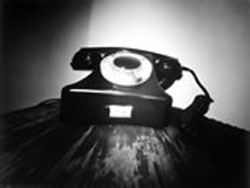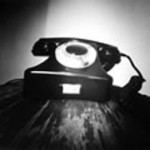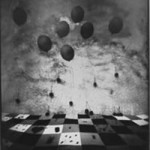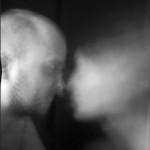Among its many processes, none evokes the Victorian origins of photography as powerfully as the pinhole image. The framing vignette, the visual distortion, and the odd mix of crisp focus and blurry confusion all combine to remind us of the mystery and magic that photographs once inspired. Each of the artists of "Made In Poland" play at the edges of our expectations, creating images that are not records of our world, but a reimagining of our perception of it.
Curators Jesseca Feguson and Walter Crump have put together seven Polish artists working with pinhole, yet the show as a whole is tightly unified by the creative process and the resulting black-and-white prints. A first glance might imply that the images are all by the same artist, yet closer inspection reveals a range of themes buried in the dense imagery.
Most striking for me were the pictures by Edyta Wypierowska, whose tiny stages appear as if they might be the sites of dreams. Each image contains a checkerboard pattern on the floor, hinting at kitchens and restaurants, or sites of pleasure. In one a horse waits, another features floating balloons, and a third is home to a covered table against a richly textured wall. Wypierowska's consistend use of the checkerboard floor creates a sense of narrative running through the pictures, a dream-like thread that may not be easily followed, but lets one wake happy.
Andrzej Bogacz also explores the visual distortion of pinhole, but in a very direct way. His images show everyday objects, such as chairs, telephones and glasses, made strangely supernatural by the process.
Several artists explore the possibilities of multiple exposure with the pinhole process. Marek Noniewicz creates layered, almost abstract pictures of overlaying grids. These disorienting pictures offer no sense of location, up or down, yet they are full of movement and energy. Tomasz Dobiszewski, in contrast, creates very meticulous multiple exposures of nude models that reference the images of Edweard Muybridge, and imply the scientific considerations of early photographers.
The ghost-like images of Danuta Gibka haunt the corner of the gallery, like records of an excorsism. In "Dana and Artur" a couple appears on the verge of a kiss, their glowing faces turned toward each other mysteriously.
For those interested in the process, the gallery also features the actual pinhole cameras used by the artists. These little boxes, cans, and other simple devices show how truly creative the process of pinhole can be. Like the ancient tools of a long-lost art, these cameras sit under glass surrounded by the mysterious and wonderful creations of their makers.
- Andrzej Bogacz, from the series Nine memories of Grandmother, gelatin silver print, 2002.
- Edyta Wypierowska, Untitled, gelatin silver print, 2005.
- Danuta Gibka, Dana and Artur, gelatin silver print, 1999.
Links:
The Art Institute of Boston at Lesley University
Made in Poland: Contemporary Pinhole Photography
"Made in Poland: Contemporary Pinhole Photography" is on view January 29 – March 4, 2007 at The AIB Main Gallery at 700 Beacon Street.
All images are courtesy of the artist and insert venue name.







